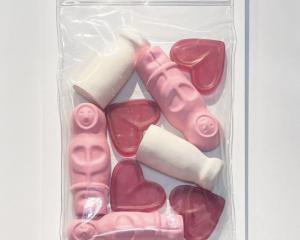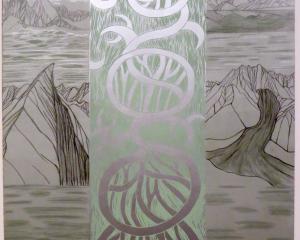The viewing experience of Nick Austin's exhibition ''The Liquid Dossier'' in the gallery of the Hocken Collections has much in common with the detective work daily taking place in the lower-floor archives. Downstairs, researchers and genealogists piece together apparently unrelated materials and compile dossier files to create a cohesive narrative.
Upstairs, Austin's work requires a similar level of personal interaction with the images on display. This is not art where form and meaning are immediately explicit, unified and easily accessible. These are works which demand the participation of their audience and which will likely inspire different questions, reactions and interpretations from each individual viewer.
Austin uses a variety of media and contrasts acrylic paintings such as Homesick (2012) with particularly successful installation pieces like the whimsical Dentists on holiday (2012), which incorporates light, sound and video to create a dream-like dental surgery where the technicians would rather be at the beach and the roar of Jet Ski engines is uncannily reminiscent of the drone of the drill.
Austin was the 2012 recipient of the Frances Hodgkins Fellowship. This exhibition is the showcase presentation of a year spent creating investigations into art within the environment of the university.
''The Liquid Dossier'' references and challenges the administrative nature of institutions like the Hocken and their attempts to classify history, pointing to the futility of applying fixed meanings and labels to something infinite and nebulous.
Claire Beynon, Olav Nielsen and Kate Alterio are now sharing gallery space at The Artist's Room for their joint exhibition ''In Dialogue''. There is wide variation between the three artists in terms of concept and technique but, as the title would suggest, the works are interspersed throughout the room to inform and contrast one another. The collective result is both successful and surprisingly cohesive despite the very distinct individual styles, but some of the less compelling pieces suffer in close proximity to the truly exceptional.
Beynon and Alterio have exhibited together in the past and share an aptitude for conveying and provoking emotion through abstracted form and a judicious use of colour (or absence of colour in the case of Alterio's poignant black and white pieces). Beynon's The Sharp Flat Cadences of Weather and Alterio's Open Page are among the more striking works.
A standout piece is Nielsen's burnished aquatint Safe Passage, which features a passageway etched in painstaking and ornate detail. The tint of blue-green illumination gives a faintly underwater effect, as if depicting a scene of below-deck splendour on an old-fashioned ship. Careful shading around the stairway is evocative of recent movement, with the sense that spirited figures might have just swished out of sight aided by the gallery's soundtrack of background jazz. The original zinc plate for Safe Passage is also available as a separate work and stands as a silent, ghostly counterpart to the liveliness of the print. Nielsen is earning a deserved reputation as a mezzotint artist and every work in the exhibition highlights his technical skill and outstanding eye for colour.
The current Ian Scott and Ray Ching exhibitions offer an excellent opportunity to view the works of two well-established names in the New Zealand art world. Their radically opposite approaches in style create an effective contrast between Scott's geometric study of pattern and Ching's narrative-driven mythology and story tale.
The outer room of the galleries begins with Scott's investigation into the properties of design and colour, while the inner section shifts the emphasis from medium to subject with Ching's local re-envisioning of Aesop's Fables. Scott, who trained under Colin McCahon, has been compared to abstract painters such as Frank Stella but has worked to achieve a unique body of work.
''Lattices'' is a retrospective exhibition with works ranging from 1978 to 2008, a select overview of a series to which he has consistently returned. Several of the works delve into experimentation with pastels, but most striking are those focused on primary colours, as in the large-scale Lattice 132 (1986). Ching's series ''Aesop's Kiwi Fables'' reworks the traditional tales into a distinctly New Zealand setting. The works are painted on red-framed boards rather than canvas, lending the impression of looking through windows into the pages of a storybook. Ching is best known for his highly skilled bird paintings and it is the avian subjects such as The Crab in the Paddock (2012) that are here rendered in the most exquisite detail. His strong handling of human figures also commands attention, however, with the earthy solidity of the girl's form in The Student and Her Flowers (2010) adding grounding realism to an otherwise ethereal image.
- Laura Elliot.







![Untitled (c. mid 1990s, [pink 3]), by Martin Thompson, 415mm×590mm. Photo: courtesy of Brett...](https://www.odt.co.nz/sites/default/files/styles/odt_landscape_small_related_stories/public/story/2024/02/untitled_pink_3.jpg?itok=Q0aQrc9o)




